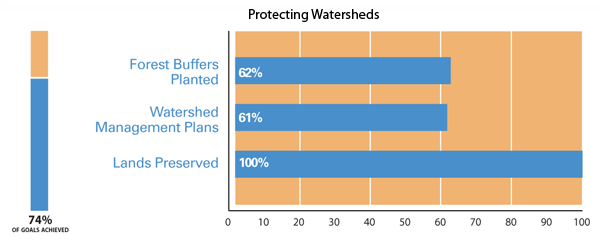The Chesapeake Bay is a region defined by the rivers and tributaries that make up the bay's 64,000 square-mile-watershed. This expansive watershed is home to over 16.6 million people in six states and Washington, D.C. Since the boundaries of the watershed cross multiple governing bodies, and runoff from the smallest of tributaries effects organisms downstream, legislation is passed and enforced on various scales to control air and water pollution. Just as Dicken (2007) says that regionalism is important for global economy, it is just as useful for conservation efforts. The Chesapeake Executive Council includes members from the EPA, the Chesapeake Bay Commission, Maryland, Pennsylvania, Virginia, and Washington, D.C. There are also 615 nonprofit organizations that work at the grassroots level. The Program encourages the participation of the general public by giving tips on how to be better watershed inhabitants and give access to volunteer opportunities. It is important to include local, state, and federal governments in this process because each scale has a different investment in the program. "Spatial scales are never fixed, but are perpetually redefined, contested and restructured in terms of their extent, content, relative importance, and interrelations" (Swyngedouw 2004 ).
Map of Nonprofit Partners of the Chesapeake Bay Program:
Click image to access live GoogleMap.
The Chesapeake Bay Program is successful in its attempts to incorporate players from various levels. Their goal is to protect two-thirds of the watershed, a total of 22.7 million acres, in VA, PA, MD, and DC by 2010. As of 2008, 61% of the watershed management plans are complete, 103% of the land is preserved, and 62% of the planned forest buffers have been successfully planted. In addition to these successes, there are also some challenges the Program still needs to address. The states have not lost power to the national mandates, but like the Nariva Swamp conservation project in Trinidad, the various states "have maneuvered through its various agencies to benefit" from the restoration and preservation of the bay (Sletto 2002).
Click image to see more results.
The headwater regions are key in preserving water quality because everything that stems from these source points will affect the rest of the downstream tributaries. That New York, Delaware, and West Virginia are only considered headwater partners and do not participate in the Program's goal oriented efforts is a weakness for the whole organization. While these states have signed agreements saying they will comply with certain standards, they are not taking the initiative to reforest buffer zones, preserve lands, or have detailed watershed management plans. This is a threat to the program's main goals for water quality.
